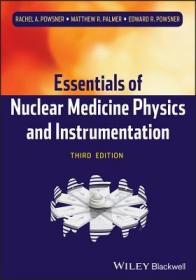
现货 Nuclear Medicine Physics 3e[9780470905500]
¥ 915 九五品
仅1件
上海宝山
认证卖家担保交易快速发货售后保障
作者Powsner, Rachel A ; Palmer, Matthew R ; Powsner, Edward R
出版社Wiley-Blackwell
ISBN9780470905500
出版时间2013-04
装帧平装
纸张其他
页数248页
正文语种英语
上书时间2023-04-11
- 最新上架
商品详情
- 品相描述:九五品
- 商品描述
- Essentials of Nuclear Medicine Physics and Instrumentation, 3rd edition presents a thoughtful revision and expansion of this finely developed, illustrated review and introductory guide to nuclear medicine physics and instrumentation for physicians, nuclear medicine residents, cardiology fellows, and nuclear medicine technology trainees. The authors strive to teach nuclear medicine-related physics and engineering concepts as clearly and concisely as possible; the beautiful illustrations are meant to be an integral component of the material.? The text covers physics and instrumentation topics central to the practice of nuclear medicine.? The material includes introductory chapters on relevant quantum mechanics, methods of radionuclide production, and the interaction of radiation with matter.? The text then discusses the basic function of the components of scintillation and non-scintillation detector systems. A chapter on image reconstruction, processing, and data display is included next.? An information technology section will include discussions of PACs (picture archiving and communication systems) and DICOM (the standard format for digital imaging and communications in medicine). A detailed summary of quality control procedures for these systems is followed by chapters on radiation biology, dosimetry, and safety.? The appendix contains information on the radionuclides used in nuclear medicine practice, radiopharmaceutical dosimetry, sample dosimetry calculations, and a guide to relevant regulatory guidelines for the practice of nuclear medicine. Several technologies have become more prominent in the field of nuclear medicine since the second edition of this text.? Hybrid scanning systems, especially PET/CT and SPECT/CT, are rapidly increasing in importance in mainstream nuclear medicine practice.? As a result, practitioners especially non-radiology trained physicians and technologists are in the process of acquainting themselves with CT as an imaging modality and with the function of these dual imaging systems.? New technology based on solid state detectors is emerging and new scanner designs optimized for specific dedicated imaging applications such as cardiac, breast or thyroid are becoming more common. PAC systems are ubiquitous and underpinning the versatility of PACs is the use of a common set of rules for structuring and sending radiology images from different cameras and scanners so that they can be viewed on PACS workstations.? Image reconstruction and processing techniques are steadily improving and the new edition further expands on this topic.
— 没有更多了 —
![现货 Nuclear Medicine Physics 3e[9780470905500]](https://www0.kfzimg.com/sw/kfz-cos/kfzimg/17733071/f5444ef900f63ca4_b.jpg)

![现货Materials and Technologies of Modern Production[9783036401683]](https://www0.kfzimg.com/sw/kfz-cos/kfzimg/17733071/5fd2824531e165d7_s.jpg)
![现货Introduction to Container Ship Operations and Onboard Safety[9781032155425]](https://www0.kfzimg.com/sw/kfz-cos/kfzimg/17733071/58b7ff43ef7909ee_s.jpg)
![现货Electrophosphorescent Materials and Devices[9789814877343]](https://www0.kfzimg.com/sw/kfz-cos/kfzimg/17733071/18cc1d77bcb7b488_s.jpg)
![现货Organic Semiconductors for Optoelectronics[9781119146100]](https://www0.kfzimg.com/sw/kfz-cos/kfzimg/17733071/24c85a750c708964_s.jpg)
![现货Advances in Food Rheology and Its Applications[9780081004319]](https://www0.kfzimg.com/sw/kfz-cos/kfzimg/17733071/e0c11603c9119d4d_s.jpg)
![现货Advanced Materials and Sustainable Technologies[9783035727562]](https://www0.kfzimg.com/sw/kfz-cos/kfzimg/17733071/dced675333874c48_s.jpg)
![现货Advanced Materials and Manufacturing Engineering II[9783035712681]](https://www0.kfzimg.com/sw/kfz-cos/kfzimg/17733071/660ccfae75fa8d3e_s.jpg)
![现货Materials in Machinery and Construction[9783035718119]](https://www0.kfzimg.com/sw/kfz-cos/kfzimg/17733071/6f402060775e9daa_s.jpg)
![现货Cereal Grain Quality (Softcover Reprint of the Original 1st 1996)[9789401071772]](https://www0.kfzimg.com/sw/kfz-cos/kfzimg/17733071/f93ca1c96a97403a_s.jpg)
![现货 Nuclear Medicine Physics 3e[9780470905500]](/dist/img/error.jpg)
以下为对购买帮助不大的评价